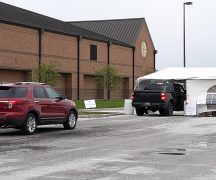By Susan Tebben
A bill to pause state testing for another year due to the impact of COVID-19 has been made more complicated by a Biden administration decision made this week.
The part of the bill that would request a waiver of federal testing was rendered moot after an announcement by the U.S. Department of Education that they will not allow blanket waivers of federal testing. Federal education officials have said they will, however, institute more flexibility on how the tests are administered.
At Tuesday’s meeting, Ohio Federation of Teachers president Melissa Cropper started off her testimony expressing her frustration in the decision by the U.S. Department of Education.
“It’s very discouraging,” Cropper said.
The federal tests are still required, but officials are allowing shorter versions of the English/Language Arts, math and science tests, and taking away a requirement that 95% of students in a district must participate.
“It sounds like instead of saying ‘let’s just forget the test this year,’ they said ‘let’s just forget the 95% (requirement) this year,’” Cropper said.
One waiver that would be allowed regards accountability, saying schools can ask that the tests not be counted against them.
The state testing bill has had three hearings, all of which included testimony supporting the waivers. Tuesday evening, the House Committee on Primary and Secondary Education heard from two opponents, one from charter-school advocates the Thomas Fordham Institute and another from the non-profit education advocacy group, Ohio Excels.
Ohio Excels the Fordham Institute previously supported the one-year pause for state testing passed last year along with other COVID-19 recovery measures.
With federal and state funds being directed toward school districts to help with recovery from the COVID-19 pandemic-related losses, Ohio Excels president Lisa Gray said these dollars should be used to help identify the exact needs of students.
“We should not take a ‘peanut butter spreading’ approach to the distribution of resources,” Gray said in her testimony.
Gray agreed with the idea that accountability shouldn’t be a part of the testing criteria this year, but she and Chad Aldis of the Fordham Institute disagreed with those that had said the results of the test wouldn’t be representative of the achievement in the subject areas or as helpful as teachers’ own evaluation of the students.
“I wouldn’t suggest that the tests are the be-all and end-all, but I do think that they provide an important information point for parents,” Gray said.
Gray cited a survey taken by about 700 parents in Ohio, who said they would like to see assessments done to show where students are, and where they need to make up lost progress. Parents surveyed in the study said they supported state testing as an achievement metric, but also trusted the schools’ own assessments of students.
The bill’s cosponsor, state Rep. Kyle Koehler, R-Springfield, debated Gray’s argument that the tests are the way to find a students’ learning level.
“You say the test would show where the child is at,” Koehler said. “I would contend that the teacher already knows.”
In previous hearings on the current bill, school superintendents and teachers unions said the state testing wouldn’t be useful in identifying gaps, because many of the students would already be gone when the results of the tests came back in June. They also said because the pandemic was a once-in-a-century obstacle to learning, the focus for teachers should be on mental health and teaching as much as possible this year, rather than immediately teaching to a test, some of which would begin in March.
The bill now moves to the full House for a vote.
***
Also from Ohio Capital Journal:
Benefits rollback bill would cost nearly $20 million in red tape, legislative analysts say
A legislative proposal to restrict eligibility for social safety net programs like food stamps or Medicaid would cost nearly $20 million to implement, according to state policy analysts.
The Ohio Legislative Service Commission, a nonpartisan arm of the state legislature that evaluates policy proposals, estimated a plan to require photo identification on every Supplemental Nutrition Assistance Program card would cost about $15 million to implement and $930,000 annually to maintain.
Senate Bill 17 would end policies known as “categorical eligibility” and “simplified reporting” that lower income reporting burdens on SNAP recipients along with the bureaucratic burden on state government. The new, more onerous income reporting system would cost about $4.5 million to implement, according to the LSC.
The bill’s lead sponsor, Sen. Tim Schaffer, R-Lancaster, said the bill is a means to combat benefits fraud and ensure monies only go to the truly needy. READ MORE
Mailbag: It’s political jockeying season in Ohio
One election cycle you’re proud allies, the next you’re Twitter enemies. That’s politics, 2021 style. Welcome back to another installment of the Ohio Capital Journal Mailbag:
Got a question about Ohio politics/government? Send them by email to tbuchanan@ohiocapitaljournal.com or tweet them to @tylerjoelb.
What can we expect timeline-wise between GOP jockeying for governor primary vs senate primary?
– Gambier Mayor Leeman Kessler, on Twitter.
Answer: Truth be told, Mr. Mayor, there’s jockeying within both parties right now. But we should have a better sense of the 2022 line-ups by the late spring.





